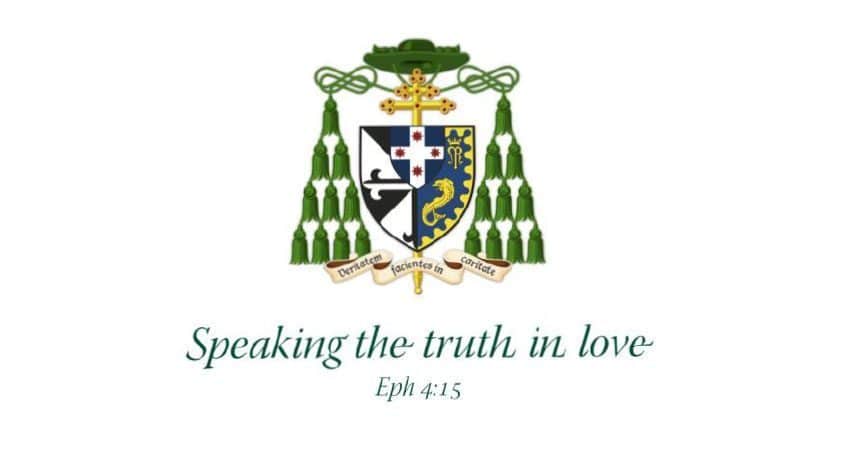“HOLY STONE”: HOMILY FOR THE EASTER VIGIL IN THE HOLY NIGHT

ST MARY’S BASILICA, SYDNEY, 30 MARCH 2024
It’s the holiest place on earth—the Basilica of the Holy Sepulchre in Jerusalem—and on entering it the first thing you see is the Stone of Unction, traditionally the slab upon which Joseph of Arimathea and Nicodemus laid out the dead Jesus to embalm Him (Jn 19:39-40). Last year I was blessed to visit that place with Father Lewi: a year later and the Holy Land is effectively closed to pilgrims. So let me give you a brief tour…
The Holy Stone is a large block of rose limestone, encased in a marble frame, that looks rather like a grave. It’s flanked at each corner by five-metre-high candles with large silver lamps hanging above. On the wall behind is a shimmering mosaic of Christ being taken down from the cross and prepared for burial. Nearby are the actual sites of Golgotha, where He was crucified, and of the ædicule encasing His tomb. Despite the best efforts of the ancient Jewish authorities and their Roman overlords, of Persian invaders and then Saracens to deter them, pilgrims have come to the site ever since Christ’s resurrection. A basilica was built over it by the emperor Constantine (326), destroyed by the Persians (614), rebuilt by the Byzantines (630), long tolerated by the Muslims (C7th onwards) but then destroyed by the fanatical caliph al-Hakim (1009). A new basilica was built by the Byzantines and the Latin crusaders (C11th & 12th), and maintained during the Ottoman empire by Greek Orthodox and Franciscan monks (C13th onwards). This church survived until the nineteenth century, when it was destroyed by fire (1808), rebuilt (1809-10) and then maintained under British mandate (1918-48) and now the state of Israel.
The first clear record of the Holy Stone of Unction is in the writings of a thirteenth-century Florentine Dominican, Riccoldo da Monte di Croce. In the travelogue of his pilgrimage to the Holy Land (1288), he gave a detailed account of Christ’s final journey, all the way to the Unction Stone.[1] The present church is oriented so the Holy Stone greets the pilgrim before progressing to Calvary and then the Sepulchre as well as other chapels. Monks incense the stone and the faithful queue to kiss it, lay objects upon it, or rub it with oil or rose-water, as if they were embalming the Lord themselves. It is surely the most anointed and caressed stone in the world.[2]
Anointing features throughout the Easter Story. : On Palm Sunday St Mark’s Passion began with an unnamed woman at the house of Simon the Leper anointing the Lord’s head with nard (Mk 14:1-9); in an alternative account, Mary the sister of Martha and Lazarus did the anointing, but of Jesus’ feet (Jn 12:1-8). Either way, the His body was being prepared in advance for burial, but Mary’s foot-washing also foreshadowed Jesus doing the same for His men on the night of His Holy Grail and unholy betrayal. Yesterday, at the end of St John’s Passion, we heard that after Jesus was thrust through with the Holy Lance, His friends Joe and Nick obtained the body for anointing with a great weight of aloes and myrrh, before wrapping and burying it (Jn 19:39-40).
Finally, in tonight’s Gospel, a fourth anointing is in prospect, when : early on the Sunday morning Mary Magdalene, James’ Mum Mary and Salome bring spices to the Tomb to finish the job they can’t trust the men to have done right (Mk 16:1-2). But on arrival they find no body! “You’re looking for ‘Jesus the Nazarene, King of the Jews’, who was crucified? Well, he has risen, he’s not here!” (cf. Mk 16:6)
It’s a conundrum. Did Mary of Bethany, Joseph and Nicodemus anoint a body for death and decay, or were they anointing Death itself with the Body of God-made-man? The Son of God didn’t need to rise from the dead: He could have cast aside His mortal nature and continued blissfully at God’s right hand. It was for our sake that He rose—for Jesus’ bodily resurrection is a promise to us all. As the Holy Grail of Maundy Thursday told of healing for now and hope for a future without sickness; as the Holy Lance of Good Friday told of peace for now and the dream of a world without violence; so the Holy Stone of Easter proclaims an end to death and a future of light and life and love.
Christ Risen means Death itself has been anointed and rededicated, now as the door to eternal life, when all is purged and forgiven, all restored and renewed, all is beauty and rest. Some of you here tonight are suffering deadly sickness or chronic pain; some, aches of heart or spirit; some are anxious about war, climate, finances, family; some worry about the future or for someone they love; some are lonely or mourning what’s lost. For you the empty tomb might seem a symbol of an empty heart, of lack of meaning, purpose and hope.
In our Exodus reading tonight Israel was saved by passing through the waters of the Red Sea—a premonition of Baptism (Ex 14:15-15:1). Then we heard God promise through Ezekiel to pour clean water over us and give us a new heart (Ezek 36:16-28). And in our epistle Paul taught that through Baptism we join Christ in death so we might rise with Him in glory (Rom 6:3-11). The Easter people are this saved, cleansed, new-hearted creation, no longer bonded to sin and death, but liberated for being united to the loving Father, for being conformed to the saving Son, for being receptive to their holy Spirit.
: Shortly, our catechumens Wang “Paul” Chan, Joceline “Alena Elizabeth” Felicia, Gimhanee “Mary” Herath, Thomas “Augustine” Lambeth, Rafael “Anthony” Lucarelli Mocelin, Kaney “Mary” Molan, Kevin “Vincent de Paul” Molan, Connor “Olaf” Rigby Ryan and Tolga “Alexander Daniel” Salman will rise with Christ. They will be joined to His Body the Church along with Jessica “Thérèse” Clissold, Michael “Paul” Donovan, Carmen “Monica” Gravatt and Rebecca “Teresa Benedicta” Mahony.
: Brothers and sisters, when the Marys heard the news that Christ had Risen, they ran to tell the others. Likewise, our newly initiated will now share that good news enthusiastically with others. They are the new Marys, the new apostles, and they should inspire in us all a similar excitement. Be mouthpieces for the Risen One as He declares: “The suffering will end. See, I have risen and so will you. By my power, all will be well!”
Word of Thanks After Communion
Dear friends: it has been wonderful to be here for this celebration of the Easter Vigil in the Holy Night. It has been a truly beautiful Mass and a fitting culmination of three days of extraordinary liturgies and devotion. I offer my heartfelt thanks to Bishop Terry Brady and our other concelebrants, the cathedral clergy, Precinct Manager and staff, our sacristans, deacons, servers and seminarians, and our year-round rosters of volunteer readers, ushers, bellringers and ministers. They’ve worked hard all Holy Week, dressed this cathedral church so beautifully, rehearsed, and then assisted at this Mass and many other ceremonies: I am enormously grateful.
The Good News of Christ’s empty tomb and His defeat for us of sin and death is news so good it should be shouted from our steeples and sung as an Alleluia chorus. For this we thank our new Director of Music, Mr Daniel Justin, our musicians, lay clerks, choristers and staff: they have done splendidly. I also thank Paula Flynn and our RCIA team for preparing our catechumens and candidates for this night, along with all who have contributed to their journey of faith. To those newest members of our Church, the newly baptised, confirmed and communicated this night: congratulations and welcome to the family of God!
This year I would also like to single out Fr Lewi Barakat, my Master of Ceremonies for the past five triduums. This is his last Easter with us as he progresses to a new ministry hereafter. I am hugely obliged to him for his friendship and support for me and for the worship and evangelisation of this cathedral.
Finally, on behalf of all the cathedral clergy and staff, and myself, a very Happy Easter to you and your loved ones. May God bless you abundantly in this holiest of seasons.
[1] https://www.terrasanctamuseum.org/en/discover-more/origins-of-the-via-dolorosa/
[2] Martin Briddle et al, The Church of the Holy Sepulchre (St Martin’s Press, 2000); Raymond Cohen, Saving the Holy Sepulchre (OUP, 2008); Kosta Kafarakis, The Church of the Holy Sepulchre: The History of Christianity in Jerusalem and the Holy City’s Most Important Church (CreateSpace, 2015); Justin Kelly, The Church of the Holy Sepulchre in Text and Archaeology (Archaeopress, 2019); Jerome Murphy-O’Connor, The Holy Land (OUP, 1998).

